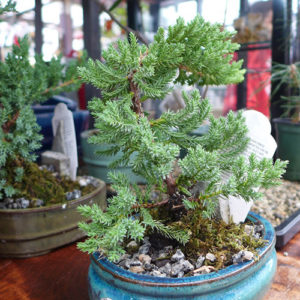 Bonsai is the art of finely-sculpting miniature trees to recreate how they appear in their natural setting. It’s a hobby suited for any gardener who enjoys spending time nurturing plants. Unlike a typical houseplant that needs intermittent care, bonsai trees need a few minutes of attention on a regular basis.
Bonsai is the art of finely-sculpting miniature trees to recreate how they appear in their natural setting. It’s a hobby suited for any gardener who enjoys spending time nurturing plants. Unlike a typical houseplant that needs intermittent care, bonsai trees need a few minutes of attention on a regular basis.
That’s because these miniaturized trees are planted in shallow pots where soil can dry quickly. But with attention to detail, bonsai trees can live to be more than 100 years old.
To see some fine examples of beautiful bonsai exhibits, take a stroll through the Bill Hosokawa Bonsai Pavilion at the Denver Botanic Gardens. When the weather warms in late spring, the trees move from the greenhouse to outside for the summer. This bonsai collection is especially relevant because it includes Colorado native species, like Ponderosa pine, Aspen and Colorado Blue spruce, some over 250 years old.
Each bonsai is like a little work of art, grown in a specific style and shaped with a sculptor’s eye while pruning the roots and branches. Each bonsai is meant to replicate the look of an ancient tree on a miniature scale.
Bonsai that take years to cultivate may cost thousands of dollars, but it’s inexpensive for beginners to get started at the hobbyist level. A suitable plant, soil, bonsai pot and scissors are all that’s needed.
A good option for bonsai beginners is to select a tree that’s meant to grow indoors. Tropical plant plants, like ficus, schefflera, portulacaria, cherry, and serissa, can do well indoors.
Bonsai can be grown outside in cold weather areas, if the tree is matched to the growing conditions. While most growers use greenhouses to protect their trees in winter, some trees can be protected through the winter in a cold frame or other sheltered area and watered to keep it from becoming dehydrated.
One of the most fascinating aspects of the hobby is that growers can start with a small tree and grow it larger or start with a large tree and grow it smaller. The difference is how it’s pruned and cared for.
Select a container that complements the tree’s size, shape and color. Most containers are shallow so they can show off some of the tree’s roots. Because of this, consistent watering is critical, and the soil should never dry out completely.
Be sure to give bonsai 5-6 hours of direct sunlight each day, whether the tree is grown inside or out.
Growing bonsai in the Japanese tradition means a little time each day is spent with the tree in quiet observation. This time allows the caretaker to observe the tree’s growth and consider how to prune, trim or wire the branches for the future.
There are some classic bonsai shapes that represent how a tree looks in its natural environment. Shapes can include formal upright, informal upright, slanting, semi-cascading, or cascading. Within these basic shapes are categories referred to as broom, windswept, driftwood or exposed root.
If you’re interested in exploring this ancient hobby, there are a number of good books that provide step-by-step instructions for getting started.


